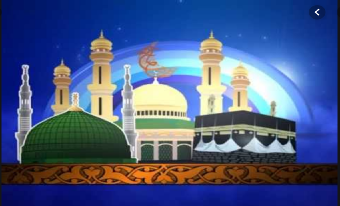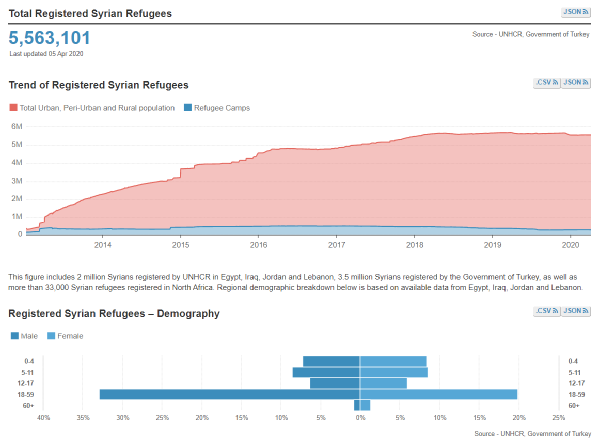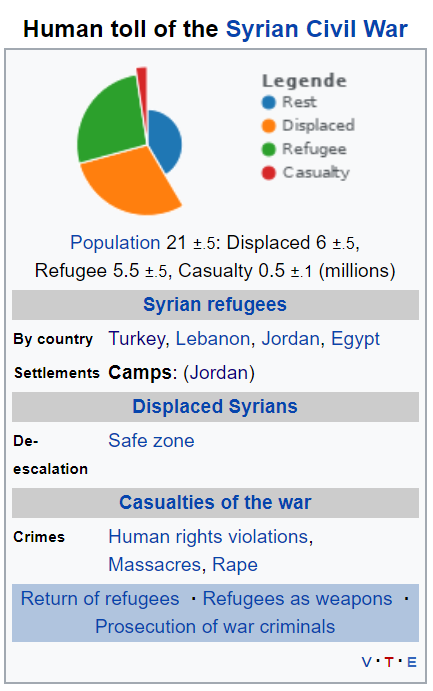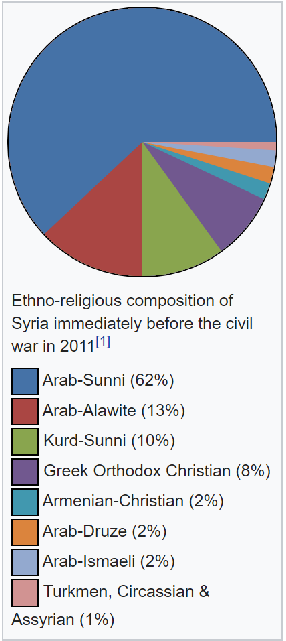|
PART 1 T O P I C |
|
|
|
|
|
|
|
|
|
|
|
|
|
|
|
|
|
|
JewishWikipedia.info
THE
INCREDIBLE
STORY OF THE JEWISH PEOPLE




|
In Syria's War, |
THE SYRIAN CIVIL WAR

SYRIAN REFUGEE CAMPS
Wikipedia,
 Syrian refugee camp and helters are temporary settlements built to receive internally displaced people and refugees of the Syrian Civil War. Of the estimated 7 million persons displaced within Syria, only a small minority live in camps or collective shelters. Similarly, of the 8 million refugees, only about 10 percent live in refugee camps, withthe vast majority living in both urban and rural areas of neighboring countries. Beside Syrians, they include Iraqis, Palestinians, Kurds, Yazidis, individuals from Somalia, and a minority of those who fled the Yemeni and Sudanese civil wars.
Syrian refugee camp and helters are temporary settlements built to receive internally displaced people and refugees of the Syrian Civil War. Of the estimated 7 million persons displaced within Syria, only a small minority live in camps or collective shelters. Similarly, of the 8 million refugees, only about 10 percent live in refugee camps, withthe vast majority living in both urban and rural areas of neighboring countries. Beside Syrians, they include Iraqis, Palestinians, Kurds, Yazidis, individuals from Somalia, and a minority of those who fled the Yemeni and Sudanese civil wars.
There were 2 million school-aged refugee children (aged 5–17 years) among the 5 million refugees registered in Turkey, Lebanon, Jordan, Iraq and Egypt by the end of 2016. 1.1 million of those children have had access to either formal education (900,000) or non-formal education (150,000), including over 6,600 Palestine refugee children from Syria. Humanitarian aid during the Syrian Civil War focuses on basic needs, health care, education and providing jobs. Most of the burden remains on the host countries, which face a stressed economy and export disruption, with the additional population, mostly outside of camps, causing significant pressure on public and private (e.g. housing) infrastructure.
From ‘The Confused Persons Guide to the Syrian Civil War’
The Atlantic Oct 29, 2015 Andrew Tabler,
an expert on Syria at the Washington Institute for Near East Policy
The Syrian Civil War is arguably the worst humanitarian crisis since the Second World War, with over a quarter million killed, roughly the same number wounded or missing, and half of Syria’s 22 million population displaced from their homes. But more than that, Syria today is the largest battlefield and generator of Sunni-Shia sectarianism the world has ever seen, with deep implications for the future boundaries of the Middle East and the spread of terrorism.
What started as an attempt by the regime of President Bashar al-Assad to shoot Syria’s largest uprising into submission has devolved into a regionalized civil war that has partitioned the country into three general areas in which U.S.-designated terrorist organizations are dominant. In Syria’s more diverse west, the Alawite and minority-dominated Assad regime, and a mosaic of Shia militias trained and funded by the Iranian Revolutionary Guard Corp (IRGC), hold sway. In the center, Sunni moderate, Islamist, and jihadist groups, such as ISIS and the al-Qaeda affiliate Jabhat al-Nusra, share control. And in the northeast, the Kurdish-based People’s Protection Units (YPG) have united two of three cantons in a bid to expand “Rojava”—Western Kurdistan. As the country has hemorrhaged people, neighboring states have carved out spheres of influence often based on sectarian agendas that tear at the fabric of Syrian society, with Iran (and now Russia) propping up the Assad regime; Turkey, Jordan, Saudi Arabia, Qatar and the U.A.E. supporting the Sunni-dominated opposition; and the Kurdistan Workers’ Party (PKK) supporting the YPG.
WHY
Why did Syria’s protests of 2011, which began in part as a response to the arrest and mistreatment of a group of young people accused of writing anti-Assad graffiti in the southern city of Deraa, morph into today’s chaos? Or as one reader asked: “What are they fighting about?” The protests started after two Arab dictators, in Tunisia and Egypt, had already stepped down amid pro-democracy demonstrations in their countries. Syria’s war is unique among the Arab Spring uprisings, but it is not unique among civil wars generally. Stanford’s James Fearon has argued that “civil wars often start due to shocks to the relative power of political groups that have strong, pre-existing policy disagreements. … War then follows as an effort to lock in … or forestall the other side’s temporary advantage.” The Syrian uprising presented just such a shock, and the opposition to Assad may have seen a short-term opportunity to press for more gains by taking up arms before their Arab Spring advantage disappeared. An International Crisis Group report from 2011 noted that Assad at first responded to protests by releasing some political prisoners and instructing officials “to pay greater attention to citizen complaints,” but that “the the regime acted as if each ... disturbance was an isolated case requiring a pin-point reaction rather than part of a national crisis that would only deepen short of radical change.”
Once a war starts, an awful logic often keeps it going, according to Fearon: “Given enormous downside risk—wholesale murder by your current enemies—genuine political and military power-sharing as an exit from civil war is rarely seriously attempted and frequently breaks down when it has been attempted.” Another complication: The Atlantic’s Dominic Tierney, among others, has argued that Assad purposely radicalized the opposition to delegitimize the rebellion, by releasing terrorists from prison and avoiding fighting ISIS.
WHEN?
To paraphrase one reader’s question: When does this end? The political-science professor Barbara F. Walter has pointed out that since the end of World War II, civil wars have lasted an average of 10 years, but that the number of factions involved is likely to prolong this one. Ben Connable and Martin Libicki of the Rand Corporation have meanwhile found that insurgencies tend to end when outside state support is withdrawn, and that “inconsistent or partial support to either side generally presages defeat.” With foreign involvement increasing on both sides, neither is likely to win, or lose, anytime soon.
GO TO THE ATLANTIC FOR OTHER CHARTS ON THE SYRIAN WAR)
IN THE SYRIAN CIVIL WAR
Wikipedia
 The Syrian Civil War is an intensely sectarian conflict. The focus of the conflict has been identified by some as a ruling minority Alawite government and allied Shi'a governments such as Iran, pitted against the country's Sunni Muslim majority who are aligned with the Syrian opposition and their Sunni Turkish and Persian Gulf state backers. However Sunni Muslims make up the majority of the Syrian Arab Army and many hold high governmental positions. Others identify it as the secular Syrian government, made up of all religious groups pitted against the Islamist opposition.[4] The conflict had drawn in other ethno-religious minorities, including Armenians, Assyrians, Druze, Palestinians, Kurds, Yazidi, Mhallami, Arab Christians, Mandaeans, Turkmens and Greeks.
The Syrian Civil War is an intensely sectarian conflict. The focus of the conflict has been identified by some as a ruling minority Alawite government and allied Shi'a governments such as Iran, pitted against the country's Sunni Muslim majority who are aligned with the Syrian opposition and their Sunni Turkish and Persian Gulf state backers. However Sunni Muslims make up the majority of the Syrian Arab Army and many hold high governmental positions. Others identify it as the secular Syrian government, made up of all religious groups pitted against the Islamist opposition.[4] The conflict had drawn in other ethno-religious minorities, including Armenians, Assyrians, Druze, Palestinians, Kurds, Yazidi, Mhallami, Arab Christians, Mandaeans, Turkmens and Greeks.
After hopes that an era of political liberalization might follow Bashar al-Assad's succession of his father these hopes flickered as Assad tightened his grip. He reined in Islamist opponents but sought to broaden his power base beyond minority sects. He promoted Sunnis to power and restored ties to Aleppo - a Sunni stronghold with which relations had been tense since the repression of the Muslim Brotherhood in the early 1980s.
He adopted a more religious aspect, leaking videos of one of his sons reciting the Qur'an. While continuing to look to Iran for military supplies he improved ties with Turkey. Yet Assad's policy of adopting a jihadi discourse on Iraq and Palestine carried risks and "enabled previously latent ethnic and sectarian tensions to surface, Sunni groups to organize, and unsettled other sects and power clusters who had prospered under his father" Hafez al-Assad.
Go to Wikipedia for full article
ISIS ISLAMIC STATE OF IRAQ AND THE LEVANT
"ISIL", "ISIS", "Daish", "Daesh" and "Islamic State group" redirect here. For other uses, see ISIL (disambiguation), ISIS (disambiguation), Daish (disambiguation), and Islamic state (disambiguation). Participant in the Syrian Civil War, Iraq War (2003–2011), Iraqi insurgency, Iraq War (2014–present), Second Libyan Civil War, Boko Haram insurgency, War in North-West Pakistan, War in Afghanistan, Yemeni Civil War, and other conflicts
Islamic State of Iraq and the Levant (ISIL, IPA /ˈaɪsᵻl/), alternatively translated as Islamic State of Iraq and Syria or Islamic State of Iraq and al-Sham (ISIS, /ˈaɪsᵻs/), is a Salafi jihadist militant group that follows an Islamic fundamentalist, Wahhabi doctrine of Sunni Islam. The group is also known as Daesh (داعش dāʿish, IPA: [ˈdaːʕiʃ]), which is an acronym derived from its Arabic name ad-Dawlah al-Islāmiyah fī 'l-ʿIrāq wa-sh-Shām (الدولة الإسلامية في العراق والشام).
The group has referred to itself as the Islamic State (About this sound الدولة الإسلامية (help·info) ad-Dawlah al-Islāmiyah) or IS since it proclaimed a worldwide caliphate in June 2014 and named Abu Bakr al-Baghdadi as its caliph. As a caliphate, it claims religious, political and military authority over all Muslims worldwide. The group's adoption of the name "Islamic State" and idea of a caliphate have been widely criticised, with the United Nations, various governments, and mainstream Muslim groups rejecting its statehood or caliphhood. As of December 2015, the group has control over vast landlocked territory in Iraq and Syria, with a population estimate ranging between 2.8 million and 8 million people and where it enforces its interpretation of sharia law. ISIL affiliates control small areas of Libya, Nigeria and Afghanistan and operate in other parts of the world, including North Africa and South Asia. ISIL gained prominence, when in early 2014 it drove Iraqi government forces out of key cities in its Western Iraq offensive,followed by the capture of Mosul and the Sinjar massacre, almost causing a collapse of the Iraqi government and prompting a renewal of US military action in Iraq. In Syria, the group has conducted ground attacks on both government forces and rebel factions. The number of fighters the group commands in Iraq and Syria, was estimated by the CIA at 31,000, with foreign fighters accounting for around two thirds, while ISIL leaders claim 40,000 fighters, with the majority being Iraqi and Syrian nationals.
Adept at social media, ISIL became notorious for its videos of beheadings of both soldiers and civilians, including journalists and aid workers, and for the destruction of cultural heritage sites. The United Nations holds ISIL responsible for human rights abuses and war crimes, and Amnesty International has charged the group with ethnic cleansing on a "historic scale" in northern Iraq. Around the world, Islamic religious leaders have overwhelmingly condemned ISIL's ideology and actions, arguing that the group has strayed from the path of true Islam and that its actions do not reflect the religion's real teachings or virtues. The group has been designated a terrorist organisation by the United Nations, the European Union and its member states, the United States, India, Indonesia, Israel, Turkey, Saudi Arabia, Syria, Iran and other countries. Over 60 countries are directly or indirectly waging war against ISIL.
The group originated as Jama'at al-Tawhid wal-Jihad in 1999, which pledged allegiance to al-Qaeda and participated in the Iraqi insurgency following the March 2003 invasion of Iraq by Western forces. Joining other Sunni insurgent groups to form the Mujahideen Shura Council, it proclaimed the formation of the Islamic State of Iraq (ISI) in October 2006. In August 2011, following the outbreak of the Syrian Civil War, ISI, under the leadership of al-Baghdadi, delegated a mission into Syria, which under the name Jabhat an-Nuṣrah li-Ahli ash-Shām (or al-Nusra Front) established a large presence in Sunni-majority Al-Raqqah, Idlib, Deir ez-Zor, and Aleppo provinces. The merger of ISI with al-Nusra Front to form the "Islamic State of Iraq and the Levant" (ISIL), as announced in April 2013 by al-Baghdadi, was however rejected by al-Nusra leader al-Julani, and by al-Qaeda leader al-Zawahiri who subsequently cut all ties with ISIL, in February 2014.
SECTARIANISM AND MINORITIES
ENDING A CIVIL WAR
The Four Things We Know About How Civil Wars End
(and What This Tells Us About Syria)
Political Violence @ a Glance, Barbara F. Walter, October 2013
The Obama Administration continues to insist that it would like to see a diplomatic solution to the civil war in Syria. But this desire flies in the face of everything we’ve learned about how civil wars have ended over the last 70+ years. Here are four things that President Obama should keep in mind as he considers the feasibility of pushing for a negotiated settlement in Syria.
- Civil wars don’t end quickly. The average length of civil wars since 1945 have been about 10 years. This suggests that the civil war in Syria is in its early stages, and not in the later stages that tend to encourage combatants to negotiate a settlement.
- The greater the number of factions, the longer a civil war tends to last. Syria’s civil war is being fought between the Assad government and at least 13 major rebel groups whose alliances are relatively fluid. This suggests that Syria’s civil war is likely to last longer than the average civil war.
- Most civil wars end in decisive military victories, not negotiated settlements. Of these wars governments have won about 40% of the time, rebels about 35% of the time. The remainder tend to end in negotiated settlements. This suggests that the civil war in Syria will not end in a negotiated settlement but will rather end on the battlefield.
- Finally, the civil wars that end in successfully negotiated settlements tend to have two things in common. First, they tend to divide political power amongst the combatants based on their position on the battlefield. This means that any negotiated settlement in Syria will need to include both the Assad regime and the Islamists, neither of whom is particularly interested in working with the other. Second, successful settlements all enjoy the help of a third party willing to ensure the safety of combatants as they demobilize. This means that even if all sides eventually agree to negotiate (i.e., due to a military stalemate or increasingly heavy costs), it’s unlikely that any country or the U.N. will be willing to send the peacekeepers necessary to help implement the peace. The likelihood of a successful negotiated settlement in Syria? Probably close to zero.
SYRIA’S ALAWITES: THE PEOPLE BEHIND ASSAD
The Alawites are usually seen as fervent supporters of Bashar al-Assad. But now they are worried—and not entirely pro-regime
Wall Street Journal Sam Dagher, June 25 2015
Alawites make up just 10% to 15% of Syria’s population, and they are usually presented as fervent supporters of Mr. Assad. Most Alawites do indeed fear that, if the Assad regime falls, they will face reprisals from the country’s majority Sunnis, who have led the rebellion against the government since March 2011. Many Sunnis see the Alawites as willing accomplices of a brutal regime that has committed atrocities against them from the time it was founded more than four decades ago by the current president’s late father, Hafez al-Assad.
Before being expelled from Syria last summer by the Assad government—for reasons never explained to me, having been this newspaper’s reporter there for two years—I spent several weeks among the Alawites, and I found a more complex and often painful story.
Mainstream Sunni Muslims have long regarded Alawites as adherents of an obscure, even heretical cult. Alawites believe that Imam Ali—a cousin of the Prophet Muhammad and a figure also revered by Shiites—was an incarnation of God, who revealed himself in six other people before Ali’s seventh-century caliphate.
In recent years, the Alawite religion’s similarities to Shiite Islam have been stressed because of the Assad regime’s alliances with Shiite Iran and with Hezbollah, the Iranian-backed Shiite Lebanese militia that has taken a large role in the Syrian conflict. But for the most part, Alawites ignore the religious practices associated with Islam, and they keep their own rituals secret.
As I discovered in my travels, their political views are often no less difficult to characterize. Some Alawites bemoaned the way they have been pushed by Mr. Assad and his regime down an irreversible path of confrontation with the country’s Sunnis.
Many Alawites fear that their community has passed a point of no return and can survive only if Syria is partitioned into smaller chunks, including one for the Alawites. In recent weeks, these anxieties have been confirmed as Islamist rebels have captured several towns and military installations in the northwestern Syrian province of Idlib, an area that many Alawites see as their first line of defense.
“We are witnesses to the country’s unraveling,” a 56-year-old Alawite public servant told me last summer in Latakia, the western coast’s main city. “Many people I know—especially those who have lost loved ones—are fed up, but few dare speak out because this would contradict the facade of defiance,” he said.
In Alawite areas, questioning Mr. Assad’s policies can be construed as treason. This is especially true as rebels and extremist groups, including Islamic State and the al Qaeda-affiliated Nusra Front, continue to execute captured Alawite soldiers and post videos of the killings.
Since the start of the conflict, the Syrian army has been hollowed out in large measure, according to defectors and officials close to Iran. They say that Alawite army officers have been removed from their regular posts and seconded to ad hoc units made up of loyalist militiamen and members of the security and intelligence agencies, often overseen by Hezbollah.
Tens of thousands of Alawites have been mustered into militias such as the so-called National Defense Force or those linked to pro-regime businesspeople. The incentive is usually money, several told me: Militia salaries can be double or triple those of army officers. “Our people are emotional and poor,” said a young lawyer from a mountain village. “It’s a ity all these young men are dying for nothing.”
In towns such as Masyaf, which straddles the fault line between the mostly Alawite mountains and the Sunni plains to the east, almost every woman I spoke to was mourning a dead or missing husband. Many were bitter, feeling abandoned by the regime.
“Nobody cares if my husband is dead or alive,” said Umm Ali, 39. She lost contact with him after he was dispatched by his army unit to the eastern province of Deir Ezzour in February 2012 and doesn’t know if he was killed or taken hostage by rebels.
I also met a woman named Ruba Fadhel, whose story underscored the depth of today’s rift among Syrians. Ms. Fadhel, 33, is an Alawite from Masyaf. Her husband, Wael Bakkour, is a Sunni from nearby Houla. They met on a public bus to Damascus and married in 2008, despite their families’ objections.
In May 2012, more than 100 people—most of them women and children—were massacred in Houla by Alawite militiamen from surrounding areas, who went on a rampage after clashes between rebels and the regime army, according to residents and a special U.N. commission investigating war crimes in Syria. At the time, the Assad regime blamed rebels for the massacre.
A month later, Mr. Bakkour, a low-ranking officer in the Syrian army (the majority of which is still Sunni) was kidnapped near Houla while heading to Masyaf to visit his family. Ms. Fadhel said that her husband’s cousins, all defectors from the army, called to tell her that they had abducted and killed him because they thought he was a spy for the regime.
But the Syrian army refused to believe her. Because her husband was a Sunni, they said he had defected to join his rebel cousins. She was denied a pension—and ostracized by her own Alawite community. “For them,” she said, “I am the terrorist’s wife.”
Many Alawites are angry at the Assad regime, but many more said that they had reconciled themselves to their destiny. Some said that their faith—and their mountains—would protect them.
So-called miracle-makers are central to the Alawite faith, and the domed mausoleums of these holy men are scattered across the coastal mountains. In one village, I saw families picnicking—grilling meat and drinking anise-flavored arrack—outside one of these shrines. Inside was a tomb, draped in green satin cloth, holding the remains of a holy man named Sheik Muhammad. Around the tomb were large portraits of Mr. Assad and his late father, as well as collages of passport-sized photos of dozens of young Alawite men killed since the start of the civil war.
Down the hill from the shrine, a 70-year-old man sat under an apple tree. He told me that the spirits of miracle-makers had always protected the Alawites and would continue to do so. “We’re going to be just fine,” he said.
IN SYRIA'S WAR, ALAWITES PAY HEAVY PRICE FOR LOYALTY TO BASHAR AL-ASSAD
The Alawites, the Assad family's sect, have seen up to a third of their young men killed in the Syrian conflict and mothers are now refusing to send their sons to war
The Telegraph Ruth Sherlock, Beirut, 07 Apr 2015
In the Assad regime's heartland, dead officers are sent home in ambulances, while the corpses of ordinary soldiers are returned in undecorated pick-up trucks.
Then come the press gangs: military recruiters raid houses to find replacements by force for the dwindling ranks of Syria's military.
Sharing their sect with President Bashar al-Assad, Alawites have long been the core constituency for the Syrian regime. As the civil war drags into its fifth year, the minority sect is seen by opposition rebels as remaining unwaveringly loyal.
But from inside the community, the picture looks very different: as their sons die in droves on the front lines, and economic privileges – subsidies and patronage – cease, Alawites increasingly feel they are tools and not the beneficiaries of the regime.
In a series of exclusive interviews, Alawites from the coastal province of Latakia, the sect's heartland, have told the Telegraph of how they are now trapped between jihadists who consider them apostates, and a remote and corrupt regime that told them the war would be easy to win.
"Most don't have salaries now, and some don't even have food to eat," said Ammar, a businessman in Latakia. "My friends ask me: 'Mr Ammar what shall we do? The regime wants to take us as soldiers. We will die. But we don't have the money to get out'."
The scale of the sect's losses is staggering: with a population of around two million, a tenth of Syria's population, the Alawites boast perhaps 250,000 men of fighting age. Today as many as one third are dead, local residents and Western diplomats say.
Rebel fighters run to avoid snipers from the forces of Syria's President Bashar al-Assad in the Selma region of the Jabal al-Akrad area in Syria's northwestern Latakia province (REUTERS)
Many Alawite villages nestled in the hills of their ancestral Latakia province are all but devoid of young men. The women dress only in mourning black.
"Every day there at least 30 men returned from the front lines in coffins," said Ammar, who spoke to the Telegraph using a pseudonym to protect himself and his family.
"In the beginning of the war their deaths were celebrated with big funerals. Now they are quietly dumped in the back of pick-up trucks."
The Syrian government has not published official figures on its war dead. Syrian state television mostly fails to broadcast news of Alawite soldiers killed, instead playing up the deaths of their Sunni comrades, in a bid to shore up Sunni support.
A report by the opposition Syrian Network for Human Rights published at the end of last year found that pro-government fighting groups have suffered the greatest proportion of casualties , with over 22,000 soldiers and militiamen killed in 2014 alone.
A disproportionate number of those are Alawites: "In battles with Sunni armed groups, the government doesn't trust their Sunni soldiers not to defect," said one Alawite resident, a former soldier, who asked not to be named. "So the Alawites are sent forward."
The loss of life is causing a quiet rebellion among many in the sect: vilified by the increasingly extremist rebel opposition, most still feel they have little choice but to remain wedded to the regime. But it is an alliance tinged with hatred.
A female resident in Latakia city, also speaking anonymously, said: "Mothers are caring for their children more than for Bashar, and have started trying to hide them away."
Pushed to breaking point, and inspired by the instinct to protect, residents recounted cases where women set up "road blocks" at the entrances to some of the mountain villages to prevent the army from forcibly taking their sons to the military draft.
"They told the military commanders: 'Go and bring the sons of the big shots to war and after that we will give you our children'," said Ammar, citing one such protest where he was present.
The community is also the focus of the rebel movement, which is now dominated by Sunni jihadists who regard the Alawites as non-believers. They openly boast of their desire to "purge" what they describe as "dangerous filth'" from the country.
Alawites, who split from the Shia branch of the Islamic faith in the ninth century, believe prayers are not necessary and do not fast or perform pilgrimages. Many of the key tenets of the faith are secret, adding to their mystique but also fuelling the myths peddled by their opponents.
A tough, mountain race who were originally considered something of an underclass, the Alawites rose to power after the fall of the Ottoman Empire, when Syria's French rulers needed soldiers willing to defend the regime from a Sunni uprising. They found willing recruits in the Alawites, who were only too happy to fight their Sunni "oppressors".
Their growing strength in the military led Hafez al-Assad, a general, to seize power, which he then handed to his son, Bashar. Since then the Assad regime has enriched individuals within the sect, disproportionately appointing its men to senior political, military and financial positions.
The majority of Alawites, however, are still extremely poor.
Assad regime's forces air and land attack on the area to regain control over it after Syrian opposition forces seized Latakia's Kasab town (Emin Sansar/Anadolu Agency/Getty Images)
"Assad didn't improve our salaries during his reign," said one Alawite resident. "In my village there are only a few villas dotted among hundreds of basic houses."
As the war continues with no clear end in sight, the collapse of the Syrian economy is forcing the poor into destitution.
The regime has cut subsidies that were keeping many families afloat. Electricity is intermittent in Latakia city and often cut off in the mountains. Fuel for transport and heating is expensive and hard to come by.
Local war lords are growing increasingly powerful, as men join their ranks, refusing to be sent with the military to fight in areas of the country where Alawites have almost no presence.
In their fiefdoms, the war lords are increasingly independent. The militia leaders feel able to refuse orders from commanders sent from Damascus, according to Joshua Landis, a professor of history at the University of Oklahoma who has regular contact with Syrian members of the sect.
Several members of the Assad family, once too powerful to touch, have died in Latakia in murky circumstances, that some have interpreted as a competition by others for money and local power.
Mystery surrounds the death of Muhammad al-Assad last month, a well known second cousin of President Assad, and once a feared member of the shabiha, a smuggling mafia that emerged from the Assad family in rural Latakia in the 1980’s.
Nonetheless, most of the Alawite community still believes that any actions that would seriously weaken the regime could result in their villages being overrun by an opposition hell-bent on sectarian revenge.
So, they keep their heads down, suffering in silence as their sons return in body bags.
Mohammed, the taxi driver said: "No one is smiling in Latakia now: every family has lost someone," he said. "The angel of death is working well."
Syrian Civil War and Timeline Encyclopedia Brittanica
Islamic State in Iraq and the Levant Encyclopedia Brittanica
Jihad in Syria Institute for the Study of War
Registered by UNHCR
|
|
|
CLICK BUTTON TO GO TO |
|
JUDY’S STORY - THE HEROISM |
